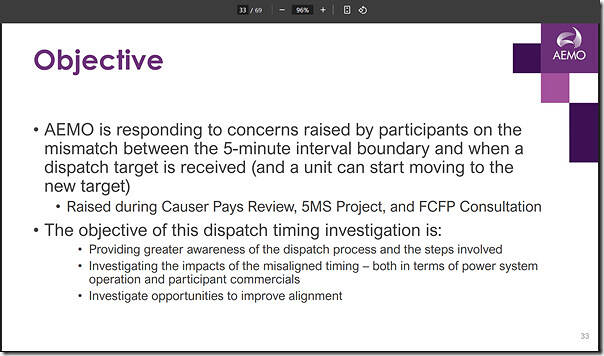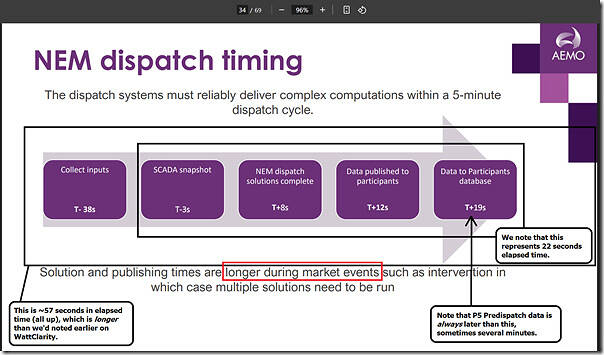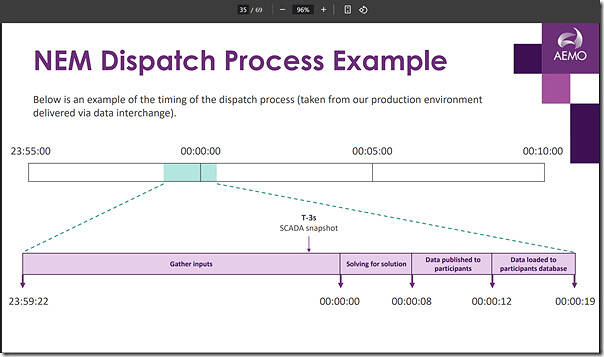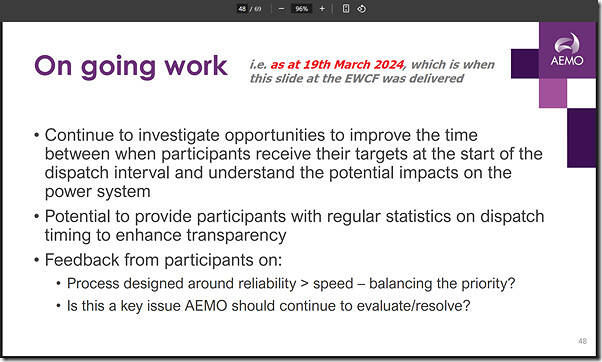On 3rd March we posted ‘Watt’s Within a Dispatch Interval? A *very* simplistic view, for a start…’, which itself followed on from ‘Three of the common building blocks within the National Electricity Market’ a day earlier.
In that second article we deliberately presented a very simplified (very simplistic) illustration of what happens within a dispatch interval, during which we separated a dispatch interval into two stages as follows:
Stage 1 = at the commencement of each dispatch interval we noted:
‘A very simplistic view is that we might assume that ‘Magic Happens’ within an infinitesimally small instant in time between the prior dispatch interval and the next one (to produce Prices, Dispatch Targets, and other Outputs).’
Stage 2 = which meant that the simplistic view holds that there’s a contiguous 5 minute period…
‘Equally simplistic can be a view of what happens across each 5-minute period.’
Then on 5th March, we posted ‘(A first step into the complexities of) the Dispatch Interval in the Real World’ to expand on the ‘Magic Happens’ stage, noting that:
(a) It takes something like ~35 seconds to achieve, end-to-end (i.e. it’s definitely not ‘infinitesimally small’);
(b) And indeed some ~20 seconds of that intrudes into the start of the next dispatch interval … which has particular implications for the rest of what happens in that dispatch interval, including conformance, compliance and generally ‘keeping the lights on’.
So it’s worth noting that there’s been a discussion running through the NEM Reform Electricity Wholesale Consultative Forum (EWCF) for over 12 months that has even been given its own title:
‘ICF 002 – Time taken for Dispatch Targets to be made available to participants’
The EWCF meeting on 19th March 2024 (i.e. meeting #14) provided some particular context on the issue:
1) In particular, readers might like to review the Slides for Meeting #14 (pay particular attention to slides 33 to 48),
2) Note that there were some Minutes for Meeting #14 as well that record some participant comments and questions.
AEMO’s stated objective (as at 19th March 2024)
In this article I’ll copy in a couple slides from the set to highlight a couple things, starting with Slide 33, which stated the AEMO’s objective in its investigation as follows …
Given that this AEMO process is still ongoing (and that an update might be provided in the EWCF meeting next week) we’re helping the AEMO out by helping to promote ‘greater awareness’ of all three of the following:
1) The complexities in the dispatch process; and also
2) AEMO’s ongoing investigations into such, and
3) One of the possible approaches AEMO has been considering:
(a) That some believe might provide a resolution to these issues;
(b) But for which we (and others) have some reservations.
AEMO’s illustrations of the dispatch process
On the next slide, the AEMO provided this illustration of the timing within key steps within the dispatch process:
… which was illustrated further on the next slide:
Following from this, slides 36 to 46 provided some initial analysis of each of the 4 steps noted above, and many readers here will find it useful to explore in some detail.
AEMO’s question (as at 19th March 2024)
AEMO concluded the presentation at the 19th March 2024 meeting with slide 48 as follows:
More information …
We’ll need to wind forward through a few subsequent EWCF meetings to arrive at more information … including:
1) ‘What’s the problem(s) with dispatch targets arriving ~20 seconds into the Dispatch Interval?’ and also
2) ‘What’s the AEMO been considering, as a possible solution to the delayed receipt of Target?’ ; and
3) ‘Why we have reservations about the possible solution AEMO has been considering’.






Leave a comment